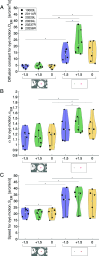A paradoxical misperception of relative motion
- PMID: 39570307
- PMCID: PMC11621632
- DOI: 10.1073/pnas.2410755121
A paradoxical misperception of relative motion
Erratum in
-
Correction for D'Angelo et al., A paradoxical misperception of relative motion.Proc Natl Acad Sci U S A. 2025 Jan 21;122(3):e2425771122. doi: 10.1073/pnas.2425771122. Epub 2025 Jan 2. Proc Natl Acad Sci U S A. 2025. PMID: 39745984 Free PMC article. No abstract available.
Abstract
Detecting the motion of an object relative to a world-fixed frame of reference is an exquisite human capability [G. E. Legge, F. Campbell, Vis. Res. 21, 205-213 (1981)]. However, there is a special condition where humans are unable to accurately detect relative motion: Images moving in a direction consistent with retinal slip where the motion is unnaturally amplified can, under some conditions, appear stable [D. W. Arathorn, S. B. Stevenson, Q. Yang, P. Tiruveedhula, A. Roorda, J. Vis. 13, 22 (2013)]. We asked: Is world-fixed retinal image background content necessary for the visual system to compute the direction of eye motion, and consequently generate stable percepts of images moving with amplified slip? Or, are nonvisual cues sufficient? Subjects adjusted the parameters of a stimulus moving in a random trajectory to match the perceived motion of images moving contingent to the retina. Experiments were done with and without retinal image background content. The perceived motion of stimuli moving with amplified retinal slip was suppressed in the presence of a visible background; however, higher magnitudes of motion were perceived under conditions when there was none. Our results demonstrate that the presence of retinal image background content is essential for the visual system to compute its direction of motion. The visual content that might be thought to provide a strong frame of reference to detect amplified retinal slips, instead paradoxically drives the misperception of relative motion.
Keywords: adaptive optics; eye movements; motion perception.
Conflict of interest statement
Competing interests statement:P.T. and A.R. are co-inventors on US Patent #10130253, assigned to the University of California.
Figures






Update of
-
A paradoxical misperception of relative motion.bioRxiv [Preprint]. 2024 Jun 6:2024.06.04.596708. doi: 10.1101/2024.06.04.596708. bioRxiv. 2024. Update in: Proc Natl Acad Sci U S A. 2024 Nov 26;121(48):e2410755121. doi: 10.1073/pnas.2410755121. PMID: 38895454 Free PMC article. Updated. Preprint.
References
-
- Legge G. E., Campbell F., Displacement detection in human vision. Vis. Res. 21, 205–213 (1981). - PubMed
-
- Westheimer G., Visual acuity and hyperacuity. Invest. Ophthalmol. Vis. Sci. 14, 570–572 (1975). - PubMed
-
- McKee S. P., Welch L., Taylor D. G., Bowne S. F., Finding the common bond: Stereoacuity and the other hyperacuities. Vis. Res. 30, 879–891 (1990). - PubMed
-
- Riggs L. A., Ratliff F., Cornsweet J. C., Cornsweet T. N., The disappearance of steadily fixated visual test objects. J. Opt. Soc. Am. 43, 495–501 (1953). - PubMed
MeSH terms
Grants and funding
LinkOut - more resources
Full Text Sources

